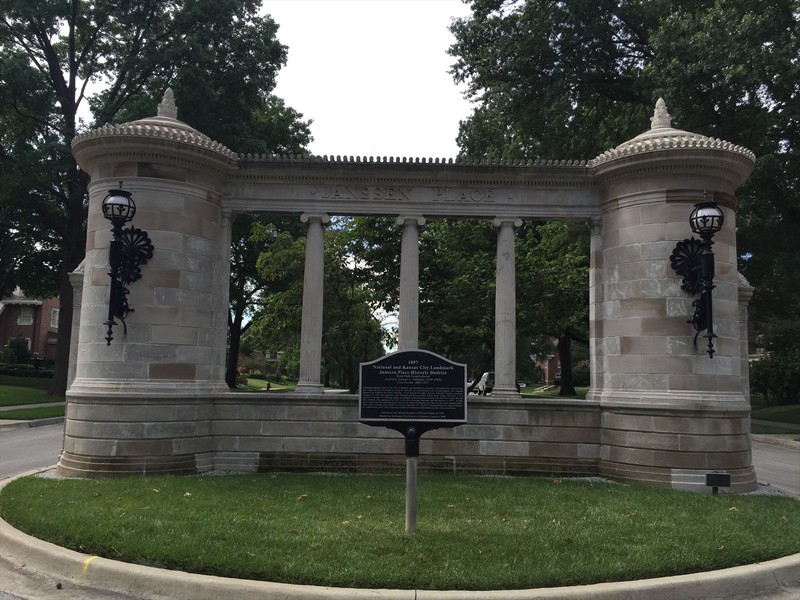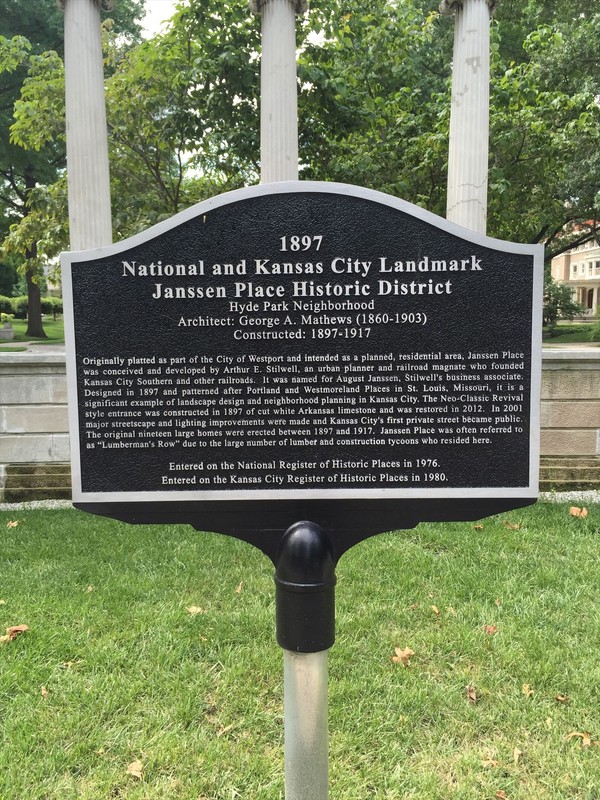Janssen Place Historic District Historical Marker
Introduction
Text-to-speech Audio
Janssen Place Historic District preserves what was once an upper class, privately owned neighborhood established in 1897 by prominent developer and railroad magnate Arthur Edward Stilwell (1859-1928). The neighborhood is an example of the landscape and community planning that occurred in Kansas City at the turn-of-the 20th century. The street is no longer private. Before the 1890s, development of Kansas City was rapid and mostly unplanned. This began to change in 1893 when the city devised a development plan consisting of parks and parkways following the city's unique topography. Before the plan could be fully implemented, however, Stilwell created Janssen Place. Instead of conforming to the topography, it consists of a straight boulevard street with homes on each side and a neoclassical style entrance gateway on the north end. The district was added to the National Register of Historic Places in 1976 and this historical marker and stone wall mark the entrance to the historic community.
Images
Janssen Place was established in 1897 by Arthur Stilwell. It became known as "lumberman's row" for all of the wealthy lumber and construction tycoons who lived in the neighborhood.


Backstory and Context
Text-to-speech Audio
Arthur Stilwell was born in 1859 in Rochester, New York. Two of his first jobs were working as a special agent for the Travelers Insurance Company and as a state agent for the Connecticut and Rhode Island Company. He arrived in Kansas City in 1889 (he first came in 1879 but left for health reasons) and established the Missouri, Kansas and Texas Trust Company. While this was successful, Stilwell wanted to follow in the footsteps of his grandfather, Hamblin Stilwell, who was one of the builders of the New York Central Railroad and the Erie Canal. To this end, Stilwell established the Kansas City, Pittsburgh, and Gulf Railroad and promoted its extension to the Gulf of Mexico. This dream was finally achieved in 1897. The company also acquired other railroads. Over his lifetime, Stilwell established over 40 corporations in a variety areas including terminals and grain enterprises.
Real estate development was another interest of his. He established Janssen Place Land Company on July 14, 1897 and soon began to plat the street. Janssen Place is named in honor of Dutch capitalist August Janssen, who invested heavily in the Kansas City, Pittsburgh, and Gulf Railroad. Stilwell hired local architect George A. Mathews to design the layout. No fences were allowed to be built between the homes. The entranceway was built using limestone from Arkansas. It consists of a central structure with pairs of pillars on each side. The central part features two large piers with an open screen consisting of three Ionic columns supporting an entablature with the inscribed words "Janssen Place." The top of the piers feature finials and ornate cornices. The entranceway was meant to indicate the exclusiveness of the neighborhood.
Interestingly, few were interested in Janssen Place initially; just three homes were built. At the time, it was located at the southern outskirts of the city which many considered too far south. The land company was sold to a local capitalist in 1906. During his tenure, 16 homes were built between 1907 and 1917. The residents who lived here were mostly in the lumber industry. As a result, Janssen Place became known as "lumberman's row." The street became public in 2001.
Cite This Entry
M., Ben and Clio Admin. "Janssen Place Historic District Historical Marker." Clio: Your Guide to History. September 29, 2022. Accessed April 2, 2025. https://theclio.com/entry/157579
Sources
"1897 National and Kansas City Landmark Janssen Place Historic District." The Historical Marker Database. Accessed September 28, 2022. https://www.hmdb.org/m.asp?m=194979.
Karel, Victoria & Miszczuk, Edward J. "Janssen Place Historic District." National Park Service - National Register of Historic Places Nomination Form. November 7, 1976. https://mostateparks.com/sites/mostateparks/files/Janssen%20Place%20HD.pdf.
Both images via The Historical Marker Database

